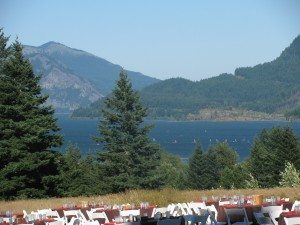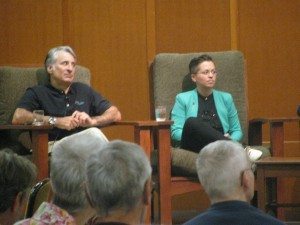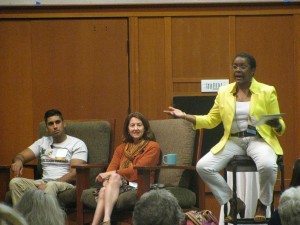Report from the National Audubon convention
By Ilana DeBare
Earlier this month Audubon held its first national convention in 13 years, and Golden Gate Bird Alliance was represented by two staff members, three board members, and one of our Eco-Education high school interns.
We’re grateful to National Audubon for donating two scholarships that allowed intern Asma Ayyad and Eco-Ed Director Anthony DeCicco to register for free. Meanwhile, I also got a free registration for suggesting the tagline for the convention, Taking Flight Together! 🙂
The convention was held in the Columbia River Gorge, on the Washington state side of the river but only about 45 minutes from Portland, Oregon. The area was beautiful, and there were some remarkable field trips available before and after the convention. (GGBA board member Linda Vallee visited one of the world’s largest Caspian Tern nesting sites; I toured the Tualatin National Wildlife Refuge and some Willamette Valley wineries, including one that uses falcons to scare off birds that would eat the grapes).


But the convention itself was the heart of the weekend… over 400 local Audubon leaders from chapters ranging from Florida to Idaho. There were workshops on conservation strategy, and on nuts-and-bolts skills for running our chapters. (I myself went to more of the nuts-and-bolts ones.) There were also several general sessions led by National Audubon President David Yarnold, including one on fostering diversity within our organizations.
Far too much to fit into one blog post without putting you all to sleep. So here are my own personal takeaways, in a nutshell:
There is a National Audubon! I had worked for GGBA for 18 months and felt no connection to National, other than the emails I keep getting as an individual member asking for money. 🙂 As far as my daily work life, they were no different from any other national conservation group like NRDC or World Wildlife Fund. But I came away from the convention with a sense of unified direction… and knowing resource people I can call at the national office… and some possible offers of help from National (more on that below)… in short, feeling part of a national organization for the first time.
Impressed with David Yarnold. Formerly the editor of the San Jose Mercury News, David has been CEO and President of National Audubon since 2010. He was personable, humble, funny and presented some clear visions for the organization. He managed to make both 50-year Audubon veterans and newbies feel welcome and valued. I came away confident that we’ve got a good leader at the helm.

The flyway model. Instead of organizing its work by region or state, National Audubon is organizing itself by flyways – which makes so much sense from a biological and conservation point of view. This has been true on paper for a few years, but the convention made it more real. One session was broken up by flyways, so we met with all the other chapters that are part of the Pacific Flyway area, from San Diego up through Alaska.
Resource help. I attended a couple of workshops on communications and met National’s expert social media staff, who are eager to help throughout the year with questions, advice etc. This is a field that is constantly developing, and there’s always more to learn, so it is great to have this kind of in-house expertise to draw upon. They were there before, but I didn’t know it… now I do.
Mapping technology. National rolled out a new sophisticated online mapping tool (ArcGIS) that it is making available for free to chapters. This can be used in conservation campaigns, but it can also be used to create an online map of good birding sites – something we’ve wanted to do for the Golden Gate Bird Alliance membership area for a while. (Like the great map that Sequoia Audubon has for San Mateo County.) We’re following up to see if this tool will work for what we want to do – if it does, we’ll need volunteers to help gather info on local birding sites! Email us if you might want to help.
Wide range of chapters. It was interesting to meet folks from other chapters and see the many differences, despite our shared mission. Some chapters operate their own wildlife refuges or nature centers, which provide huge opportunities to do nature education, run summer camps etc. Others like GGBA are “free-standing” without any property. Some chapters have staff; others are all-volunteer. GGBA seems to be among the largest chapters without property, but our scale (measured in staff, budget, and activities) remains smaller than chapters that operate a nature center or refuge. Portland Audubon in particular seems like a powerhouse – they have 13,000 members (!!!), are a major player in regional politics, and seem to be the primary local conservation group in their area, like if you rolled Sierra Club, Save the Bay and Audubon into one group for the whole Bay Area.

Diversity. It’s no secret that Audubon chapters tend to skew old and white, in terms of membership. But diversity had been one of David Yarnold’s major priorities when he was at the Mercury News. And he highlighted the issue at the convention, with a plenary session on why and how to broaden our base so we can be truly effective advocates for wildlife conservation. Panelist Faizel Ismail, the education manager for an Audubon nature center in Texas, talked about how we sometimes intimidate and scare away novice birders, and coined a great line: “We talk about bird-friendly communities, but first we have to be a community-friendly Audubon.”

Well, that is already more than a nutshell and you may have dozed off already! Overall, the convention was both encouraging and energizing, and left people feeling more connected to each other and to the national organization.
We’re hoping that National Audubon will host another convention in two years. If they do, please consider coming! There were too many interesting workshops for the few of us from GGBA to cover. And I think you’d find it an inspiring experience that would deepen your commitment to bird conservation here at home.
